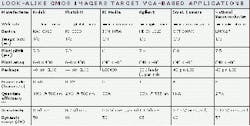Shakeout on the way for CMOS imager vendors
According to Cahners In-Stat (Newton, MA), the market for image sensors surpassed $1 billion for the first time in 1999. In that year, CMOS image sensors accounted for 7.2% of all image sensors shipped and 6.2% of revenues. The demand for low-cost, portable cameras over the next five years will drive the market share for CMOS image sensors to 50.8%, accounting for 35.5% of revenues by 2004. This increase will be due to lower cost, less power consumption, and higher on-chip integration for CMOS sensors in comparison to CCD sensors.
"A combination of new products and lower prices will help CCD technology hang on to significant market share. Despite CMOS improvements over the past five years, products that require high resolution will continue to be dominated by CCDs for the next several years," says Brian O'Rourke, industry analyst for In-Stat's Multimedia Service.
Nevertheless, several semiconductor companies without imager design experience perceive low-cost imaging as a potentially lucrative business. To enter the market, well-known semiconductor vendor STMicroelectronics (San Jose, CA) acquired VLSI Vision (Edinburgh, Scotland), a deal followed by Conexant Systems (Newport Beach, CA) purchasing Sierra Imaging (Newport Beach, CA).
At present, more than ten other vendors are competing for a share of the CMOS sensor market. These include such well-known companies as Kodak Co. (Rochester, NY), Photobit (Pasadena, CA), Agilent (Palo Alto, CA), and National Semiconductor (Dallas, TX), as well as a handful of start-ups such as IC Media (San Jose, CA), SmaL Camera (Cambridge, MA), and Pixim (Mountain View, CA).
In developing their CMOS imagers, a number of these companies have focused on producing VGA-resolution-type imagers (see table). This approach has resulted in similar products that can not be readily differentiated on product specifications alone. The effects of a plethora of me-too products has resulted in semiconductor manufacturers scrambling to differentiate their products.
To attain the goal of a camera-on-a-chip, however, imager and image-processing vendors are expected to combine skills. In some cases, large semiconductor vendors will pool resources within their company to realize such devices. In other cases, established semiconductor vendors are anticipated to purchase CMOS technology. Last year, for example, Zoran (Santa Clara, CA) bought PixelCam, a developer of CMOS image sensors. "With PixelCam, Zoran intends to offer a digital camera that combines a CMOS sensor with the company's Camera-On-A-CHip (COACH) processor," says Levy Gerzberg, Zoran president and chief executive officer.
Despite the impeding CMOS imager shakeout, start-ups continue to blossom. During the past few months, IC Media, SmaL Camera, and Pixim have all announced CMOS-based imagers. IC-Media's ICM-105A is a 640 x 480-pixel sensor array that can operate at 1 to 10 frames/s in a progressive manner. SmaL Camera also offers a VGA format imager with frame rates as high as 60 frames per second. Pixim, a spin-off from Stanford University (Stanford, CA) also aims to enter the CMOS imager market with a digital pixel sensor. Based on the work of Stanford professor Abbas El Gamal, Pixim plans to embed the device in cameras, phones, and games.

